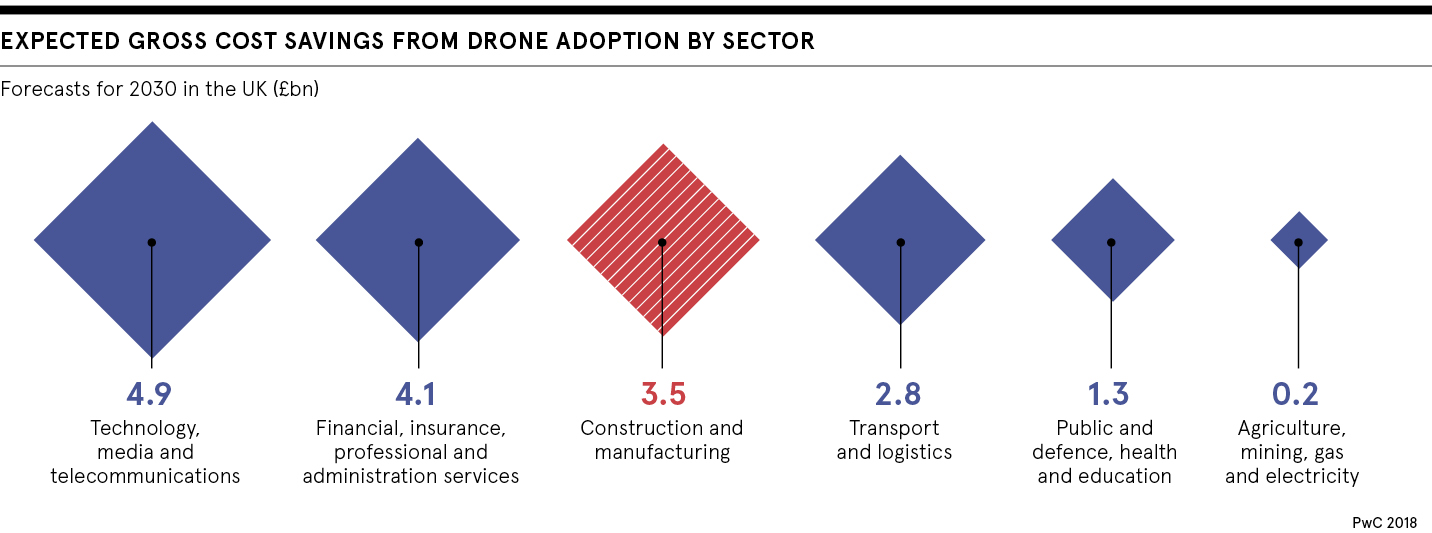Drones in Manufacturing: Benefits, Drawbacks and Outlook
August 15, 2019
Once only for kids and hobbyists, drones are becoming increasingly useful in industries of all kinds. Will drones be the new norm in manufacturing? Some say, “yes.”
Benefits
There are several areas in which drones stand to benefit manufacturing companies, including speed, safety and efficiency of operations.
- Light material handling within facilities: Picture a busy assembly plant or another kind of facility, with employees and vehicles dashing around, maintenance personnel coming and going and the maze of bollards, decking and railings humans and machines must navigate safely. Now, imagine the benefits of reducing some of that foot traffic by using drones to fly parcels and replacement parts overhead, to employees who would otherwise see their efficiency drop to close to zero while waiting for their materials to arrive. Drones equipped with RFID, sensors and GPS could also locate merchandise, raw materials and parts more efficiently than human workers can.
- Visual inspection of the premises and infrastructure: Before too long, industries will deploy drones in higher numbers to perform inspections, in responding to broken boiler pipes, for example, and to get a closer look at damage or maintenance issues that spring up at the change of the seasons, including the toll ice and snow can take on a building’s exterior.
- Warning of problems in agricultural settings: Agriculture is another compelling application for drones in manufacturing and production. Farms of all sizes can use drones to obtain incredibly detailed aerial photos and videos of vast acreage. Farmers can discover, in real-time, potentially problematic conditions like water stress, the effects of over-fertilization, pest infestations and more, before they spiral further and cause crop failure and lost profits. Using drones in this way can also help reduce fertilizer and water use, which both saves money and lessens environmental impact.
- Improved safety for human workers: Working at height, retrieving products from tall racking, troubleshooting dangerous equipment during work stoppages, responding to spills and navigating mezzanines are all challenging and potentially hazardous tasks. In time, drones could remove a lot of this work from our plates. Drones can even make it to emergency sites faster than human responders and bring needed supplies such as EpiPens, inhalers and more to out-of-the-way locations or hard-to-reach parts of facilities, mines, oil fields and more.
Right now, the real estate and photography sectors are the majority of drone users in industry, while manufacturing represents a relatively unimpressive 1.5 percent. Given the above referenced potential applications among other benefits, that percentage will more than likely increase.
Drawbacks
There are a few caveats to keep in mind as we explore the benefits of drones in manufacturing facilities and processes, path-finding, hazard programming and liability.
First, facility managers may find it prudent to rethink the layout of their warehouses and production facilities if using drones to avoid potential collisions and other interference. On the other hand, rearranging warehouse racking and rethinking common storage paradigms could be in the cards anyway. With drones picking materials from warehouse racking, versus humans piloting order pickers or lift trucks, we’ll be able to think vertically a lot more than we do now, and take advantage of untapped empty spaces.
There is also the matter of programming specialty drones to recognize and react appropriately to specific types of hazards which human workers are more accustomed to dealing with, such as welding arcs in automotive plants. As with driverless cars, many issues pose a challenge to the technology in its current state, and require careful calibration before some of these manufacturing drones reach the market in more significant numbers.
Liability remains a somewhat under-explored aspect of bringing drones into manufacturing facilities, too. One one hand, drones may release companies from some of the risks associated with sending workers into less-than-ideal situations and environments. On the other, those same companies bear responsibility for operating drones safely and with employee privacy in mind. The FAA’s guidelines for drone flight in open outdoor spaces become more, not less, relevant, as drones join us indoors, where there is considerably less freedom of movement.
Outlook
With some unanswered liability questions and current technological limitations aside, it is clear drones have an exciting future in manufacturing and other industries. In the construction sector, 92 percent of companies using drones see a return on their investment within one year. The picture is a little less clear in terms of the manufacturing industry’s ROI. The sky is literally the limit when it comes to improving the efficiency, safety and organization of our manufacturing and distribution processes.

Nichols, Ray. (2019). “Do Drones Have a Place in Manufacturing”. Retrieved from https://www.droneblog.com/2019/04/26/do-drones-have-a-place-in-manufacturing/.
